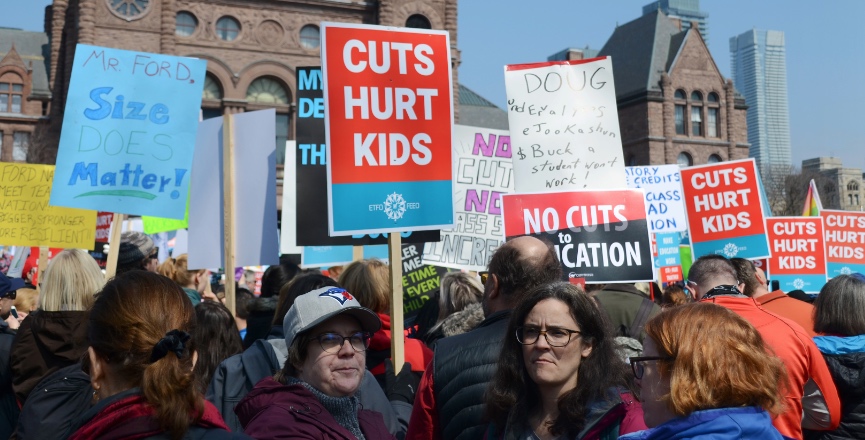The Ford government’s announcement on March 15 that it would be raising average class sizes in Ontario secondary schools from 22 to 28 was a variation on an old magician’s trick: distract people with one hand while you pick their pocket with the other.
While the government has carefully framed the issue around the topic of class sizes, the public has been kept in the dark about the real impact of the changes coming to education. What’s coming is not just larger class sizes, but the decimation of programming and the inability of schools to offer students a full range of courses — or even all the courses they need to graduate.
Unfortunately, with the Ford government introducing its budget on Thursday, by the time people realize what’s coming, it will be too late.
First, let’s be clear that this is not just about an extra six students in every class. When we talk about average class sizes, the implication is that some classes are larger and some are smaller. With a 1:22 average ratio we already have classes in the low-to-mid 30s. Increase the ratio to 1:28 and you’re talking classes of up to 40. This would be devastating for kids who are already not getting the support they need in large classes.
Though class sizes will certainly increase over the next few years, the main impact of the reduction of funding will not be larger class sizes but fewer teachers, and fewer teacher means fewer courses and fewer programs.
It’s only a matter of time before students discover that many of the courses they signed up for in the fall are gone. Students at smaller schools will even find that they can no longer get all the courses they need to graduate.
As a result, in the short term, we’re likely to see a mad rush to night school and summer school programs as students try to make up those lost credits — if, in fact, there is space. While the government is looking to expand eLearning and will be making it mandatory for all secondary students to complete four eLearning credits as a condition of graduation, the infrastructure to take on that many new students is not yet in place, and most students do not do well with eLearning.
In the Toronto District School Board, where we have “optional attendance” that allows students to apply to schools outside of their catchment area, there will likely be a spike in students fleeing smaller schools for larger ones that are still able to offer a fuller range of programming, but those schools will already be full since they too have been forced to reduce their staff. Many students could find themselves with no place to go to get their credits.
Expect to see a lot of anxious students and angry parents this fall.
There will be pressure on teacher unions during the next round of collective bargaining to raise the class caps in order to save programming, but people need to understand that many classes have class caps for reasons that have little to do with a collective agreement.
For example, safety concerns in classes for students with severe disabilities necessitate smaller classes. Same with classes that involve dangerous equipment, such as science or woodworking. Class caps are also necessary due to the physical infrastructure of the buildings. There is not a single school anywhere in this province that was built to accommodate class sizes of 40, and in some cases fire regulations set upper limits on how many kids you can pack into a room.
Regardless of how large the Ford government wants to make class sizes, there is only limited room to do so without placing schools in legally precarious situations where they are jeopardizing student safety. There are no “efficiencies” to be had here. There is nothing left for boards to do but cut programs.
Undoubtedly, the Ford government will offer their own market-driven solution to the crisis they have created in the form of vouchers for private schools and charter schools. Stay tuned.
Jason Kunin is a Toronto teacher and writer. This column was originally published in the Toronto Star.
Photo: Mary Crandall/Flickr




